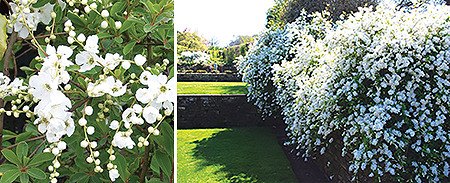Gardening Journal April 2022: Plant of the month – Exocorda x macanthra ‘the bride’
April 1st, 2022 When in flower, this deciduous shrub is just amazing. For about six weeks in April and May, its arching branches are wreathed in open white flowers that almost smother the soft green foliage.
When in flower, this deciduous shrub is just amazing. For about six weeks in April and May, its arching branches are wreathed in open white flowers that almost smother the soft green foliage.April is a great time to get back in the garden, as the weather warms up and the plants start sprouting, waking from their winter dormancy. There is lots to be done in preparation for the summer, with seeds to be sown and lawns to be mown. With all that work to be done don’t forget there is lots to enjoy in the garden too. Best of all, it’s a time where we can look forward to the light summer evenings and enjoy the outdoors properly again.
When in flower, this deciduous shrub is just amazing. For about six weeks in April and May, its arching branches are wreathed in open white flowers that almost smother the soft green foliage. In autumn the leaves turn delicate shades of yellow and orange. Although it will take some shade, it flourishes best in a sunny, open position. It can also be trained as a wall shrub, but this may be best left to the more experienced gardener.
Exochorda “The Bride” can be planted as a hedge, or as a single specimen, in a mixed shrub border or as as a feature plant surrounded by herbaceous plants. I like to plant it with Hardy Geraniums, either Patricia or Rozanne, so the stems of the Geranium climb up into the branches of the Excochorda with the flowers poking through later in the season after the Exochorda has flowered. Wherever you plant this shrub you will not be disappointed, its a great little shrub with lots of impact for a small or large garden.
Jobs to be doing this month include:
• Continue to remove faded flowers on spring bulbs but not the foliage until it has withered.
• Keep borders weed free.
• Mulch borders if not completed last month.
• If the weather is mild, then trim weak or straggly growth of sage and rosemary.
• Penstemons – Cutback last year’s stems down to the new growth – if the weather is very cold and frosty delay until end of the month.
• Check evergreens for any frost damage – lightly prune if necessary.
• If not already done so start sowing and start mowing.
In the vegetable garden:
• Plant second-early and maincrop potatoes
• Pinch out the tips of broad beans if they’re covered in aphids, or spray shoots with soap-based solution
• Sow outdoor varieties of tomatoes, chillies and courgettes in pots, so they’re ready to plant out in late May or June
• Divide clumps of hardy herbs, such as lemon balm and chives, then replant in pots, borders or a dedicated herb bed
• Sow small batches of rocket and other easy salad leaves
• Sow flowering companions in the veg plot, such as pot marigolds and borage
• Continue planting batches of garlic, shallots and onions every few weeks to extend the cropping period
• Sow herbs such as parsley, coriander, dill and chamomile in a sunny bed or container
• Protect emerging seedlings from slugs and snails
• Sow fast-growing crops, such as radishes, to make the most of any temporary gaps
Commonly known as pearl bush, Exochorda x macrantha ‘The Bride’ is a hugely popular deciduous shrub, and with good reason. In late spring and early summer, it’s awash with masses of pure white flowers, with dramatic displays that have awarded it the Royal Horticultural Society’s prestigious Award of Garden Merit (AGM).
Exochorda is a small genus of flowering plants in the family Rosaceae, native to China and central Asia. They are used as ornamental plants. Numerous species have been described on the basis of differing appearance and geographical separation, but a systematic study revealed that the different types are closely related and probably all descended from a single species that formerly had a wide distribution that has been broken up by habitat loss.
When in flower, this deciduous shrub is just amazing. For about six weeks in April and May, its arching branches are wreathed in open white flowers that almost smother the soft green foliage. In autumn the leaves turn delicate shades of yellow and orange. Although it will take some shade, it flourishes best in a sunny, open position. It can also be trained as a wall shrub, but this may be best left to the more experienced gardener.
For best results, grow Exochorda x macrantha ‘The Bride’ in moist but well-drained soil. It’s important that it is pruned right after flowering, to ensure a good show of flowers the following year. Do this by cutting back each flowering stem by half their length, after blooming has ended.
Exochorda “The Bride” can be planted as a hedge, or as a single specimen, in a mixed shrub border or as as a feature plant surrounded by herbaceous plants. I like to plant it with Hardy Geraniums, either Patricia or Rozanne, so the stems of the Geranium climb up into the branches of the Excochorda with the flowers poking through later in the season after the Exochorda has flowered. Wherever you plant this shrub you will not be disappointed, its a great little shrub with lots of impact for a small or large garden.
Jobs to be doing this month include:
• Continue to remove faded flowers on spring bulbs but not the foliage until it has withered.
• Keep borders weed free.
• Mulch borders if not completed last month.
• If the weather is mild, then trim weak or straggly growth of sage and rosemary.
• Penstemons – Cutback last year’s stems down to the new growth – if the weather is very cold and frosty delay until end of the month.
• Check evergreens for any frost damage – lightly prune if necessary.
• If not already done so start sowing and start mowing.
In the vegetable garden:
• Plant second-early and maincrop potatoes
• Pinch out the tips of broad beans if they’re covered in aphids, or spray shoots with soap-based solution
• Sow outdoor varieties of tomatoes, chillies and courgettes in pots, so they’re ready to plant out in late May or June
• Divide clumps of hardy herbs, such as lemon balm and chives, then replant in pots, borders or a dedicated herb bed
• Sow small batches of rocket and other easy salad leaves
• Sow flowering companions in the veg plot, such as pot marigolds and borage
• Continue planting batches of garlic, shallots and onions every few weeks to extend the cropping period
• Sow herbs such as parsley, coriander, dill and chamomile in a sunny bed or container
• Protect emerging seedlings from slugs and snails
• Sow fast-growing crops, such as radishes, to make the most of any temporary gaps
Comments (0)
No comments have been submitted yet.Why not be the first to send us your thoughts
Leave A Comment
Thank you for your comments, they will appear shortly once approved.
Recent Posts
Have You Seen...






